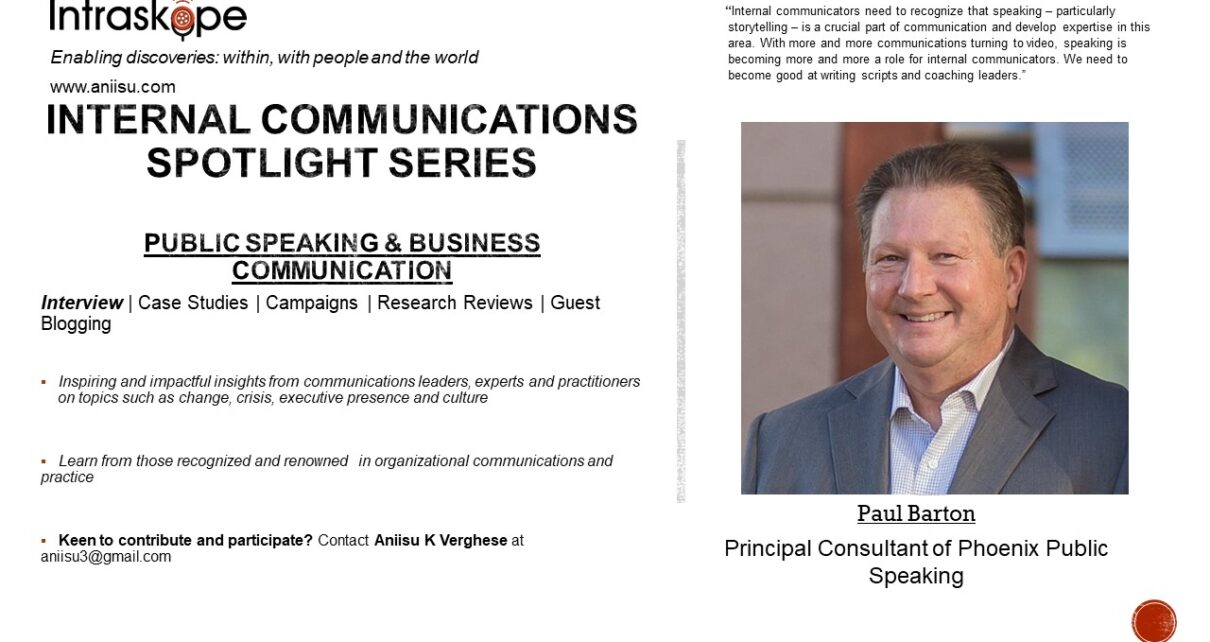Welcome to the 12th edition of Intraskope’s Spotlight Series featuring Paul Barton, ABC, the Principal Consultant of Phoenix Public Speaking. Paul is based in the US and has been a business communication strategist for 30 years including 20 years of experience directing internal communications teams at six Fortune 500 organizations. Paul is the author of Maximizing Internal Communication: Strategies to Turn Heads, Win Hearts, Engage Employees and Get Results.
About Intraskope’s Spotlight Series
In this series I interview key thought leaders on topics interrelated with internal communications such as culture, crisis, change, executive presence and leadership. The goal is to help unravel why they matter, what can leaders and communicators learn from experts and how we can put insights to practice. Watch these short interviews and get better at understanding these key topics and how you engage with internal communications.
In this conversation with Paul we explore the value of business communications, especially public speaking. We delve into the nuances that can help managers and leaders become their best selves as communicators.
“Your public speaking skills can be a career killer or a ticket to career success”, says Paul.
Interview
- What is the value and importance of business communications and public speaking in organizations?
In today’s fast-paced, competitive environment, being able to tell your story well is a business survival skill. Speaking is a critical part of the communication process, particularly in motivational and persuasive communications.
2. How important is it for leaders, managers and communicators to hone this skill?
Public speaking skills can help you get a job, get projects approved, win client and get promoted. Your public speaking skills can be a career killer or a ticket to career success.
3. What are ways in which leaders can get better at their own business communications and speaking?
Having a good public speaking coach leading you through a good program can make all the difference. Leaders should seek feedback regarding what’s connecting with their teams and what’s not.
4. What advice do you have for communicators in coaching leaders on a topic like public speaking and business communications? – especially since there is resistance to hearing feedback if they aren’t good in this space.
Internal communicators need to recognize that speaking – particularly storytelling – is a crucial part of communication and develop expertise in this area. With more and more communications turning to video, speaking is becoming more and more a role for internal communicators. We need to become good at writing scripts and coaching leaders.
5. How does, say, an introvert leader engage on business communications and public speaking when the preference is for email?
The introvert needs to tap into their passion for their company or industry and understand the power of the spoken word and storytelling.
6. With all of us online how does it change the way public speaking and business comms are done in these times?
Think about these three areas: your environment, the technology available to you, and your presentation.
Control your environment: a quiet room, well lit, uncluttered background. Look and sound your best with a good webcam, a good microphone, good lighting.
Technology: Understand all the tools available to you with your technology – chat box, polls, sharing your slides, etc.
Presentation: Good posture, make eye contact, and an upbeat and engaging tone.
7. Finally, is there a way to measure the value of public speakers’ effectiveness on the influence at the workplace?
Focus groups, surveys and common sense will show you that if the spoken word is the best tool to drive people to action. If you’re seeking a behavior change from your employees, that is most likely going to come from a face-to-face conversation between a leader and their employees. The written word and data are very good at raising awareness and getting to understand, but it is the spoken word and an emotional appeal that causes people to make a behavior change and to take action.
Watch the complete video interview on YouTube or read the complete transcript above.
Missed the earlier episodes? Watch them here: D. Mark Schumann (Culture), Peter Yorke (Executive Presence), Sia Papageorgiou (Leadership Communications), Dianne Chase (Strategic Storytelling), Gloria Walker (Communication Planning), Rebecca Sangster-Kelly (Stakeholder Management), Ray Walsh (Localizing Employee Communications), Prof. Matt Tidwell (Reputation), Geri Rhoades (Manager Communications), Erik K Meyers (Business Acumen) and Russell-Olivia Brooklands (IC Practice Governance).
You can also look up the ongoing Intraskope’s Spotlight on Internal Communication Series featuring practitioners from around the globe sharing best practices and perspectives.
Liked the interview? Post your comments and share it with your network.
Keen to participate in the ongoing series on Personal Branding, Crisis Communications, Internal Communications or CSR Communications? Drop me a note at [email protected]
Here are Internal Communications resources you can use:
- Learn: Internal Communications Fundamentals Course on Thinkific or Udemy
- Internal Communications Series: https://forms.gle/KcqmPzLwq7NQi5Km6
- Chat with Aniisu – Internal Communications: https://www.instamojo.com/intraskope/connect-with-aniisu-60-minute-personalized-d/?ref=store
- Internal Communications workshops: https://bit.ly/2zdBRl1
You can also visit my website www.intraskope.com and You Tube channel to know more about my work.
#IC #ICbusinesscommunicators #publicspeaking #businesscomms #engagement #conversations #leadership #linemanagers #authenticity #persuasion #storytelling #personality #introvert #extrovert #ambivert #internalcomms #communications #internalcommunications # #covid19 #paulbarton #intraskope

